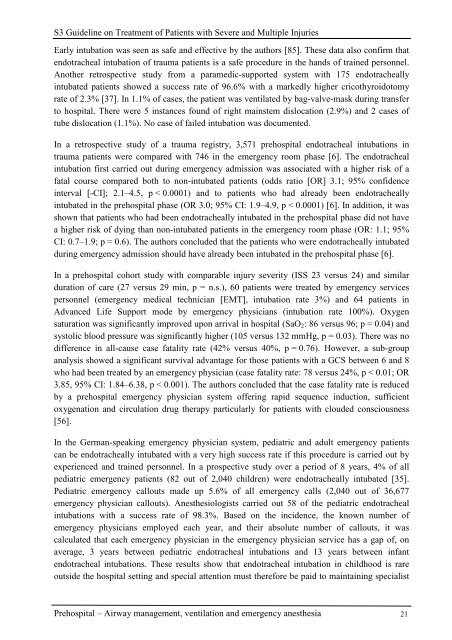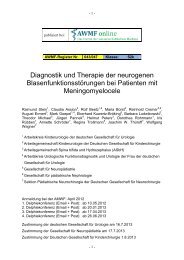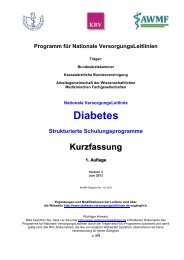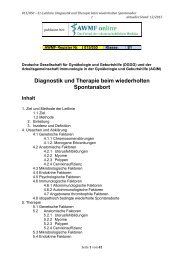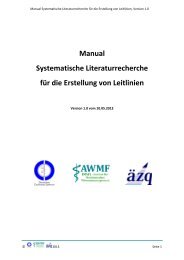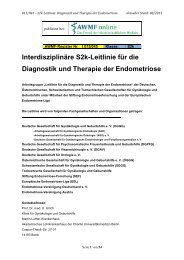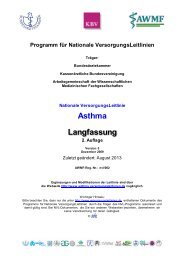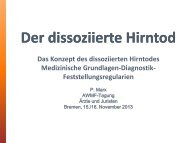Guideline on Treatment of Patients with Severe and Multiple ... - AWMF
Guideline on Treatment of Patients with Severe and Multiple ... - AWMF
Guideline on Treatment of Patients with Severe and Multiple ... - AWMF
You also want an ePaper? Increase the reach of your titles
YUMPU automatically turns print PDFs into web optimized ePapers that Google loves.
S3 <str<strong>on</strong>g>Guideline</str<strong>on</strong>g> <strong>on</strong> <strong>Treatment</strong> <strong>of</strong> <strong>Patients</strong> <strong>with</strong> <strong>Severe</strong> <strong>and</strong> <strong>Multiple</strong> Injuries<br />
Early intubati<strong>on</strong> was seen as safe <strong>and</strong> effective by the authors [85]. These data also c<strong>on</strong>firm that<br />
endotracheal intubati<strong>on</strong> <strong>of</strong> trauma patients is a safe procedure in the h<strong>and</strong>s <strong>of</strong> trained pers<strong>on</strong>nel.<br />
Another retrospective study from a paramedic-supported system <strong>with</strong> 175 endotracheally<br />
intubated patients showed a success rate <strong>of</strong> 96.6% <strong>with</strong> a markedly higher cricothyroidotomy<br />
rate <strong>of</strong> 2.3% [37]. In 1.1% <strong>of</strong> cases, the patient was ventilated by bag-valve-mask during transfer<br />
to hospital. There were 5 instances found <strong>of</strong> right mainstem dislocati<strong>on</strong> (2.9%) <strong>and</strong> 2 cases <strong>of</strong><br />
tube dislocati<strong>on</strong> (1.1%). No case <strong>of</strong> failed intubati<strong>on</strong> was documented.<br />
In a retrospective study <strong>of</strong> a trauma registry, 3,571 prehospital endotracheal intubati<strong>on</strong>s in<br />
trauma patients were compared <strong>with</strong> 746 in the emergency room phase [6]. The endotracheal<br />
intubati<strong>on</strong> first carried out during emergency admissi<strong>on</strong> was associated <strong>with</strong> a higher risk <strong>of</strong> a<br />
fatal course compared both to n<strong>on</strong>-intubated patients (odds ratio [OR] 3.1; 95% c<strong>on</strong>fidence<br />
interval [-CI]; 2.1–4.5, p < 0.0001) <strong>and</strong> to patients who had already been endotracheally<br />
intubated in the prehospital phase (OR 3.0; 95% CI: 1.9–4.9, p < 0.0001) [6]. In additi<strong>on</strong>, it was<br />
shown that patients who had been endotracheally intubated in the prehospital phase did not have<br />
a higher risk <strong>of</strong> dying than n<strong>on</strong>-intubated patients in the emergency room phase (OR: 1.1; 95%<br />
CI: 0.7–1.9; p = 0.6). The authors c<strong>on</strong>cluded that the patients who were endotracheally intubated<br />
during emergency admissi<strong>on</strong> should have already been intubated in the prehospital phase [6].<br />
In a prehospital cohort study <strong>with</strong> comparable injury severity (ISS 23 versus 24) <strong>and</strong> similar<br />
durati<strong>on</strong> <strong>of</strong> care (27 versus 29 min, p = n.s.), 60 patients were treated by emergency services<br />
pers<strong>on</strong>nel (emergency medical technician [EMT], intubati<strong>on</strong> rate 3%) <strong>and</strong> 64 patients in<br />
Advanced Life Support mode by emergency physicians (intubati<strong>on</strong> rate 100%). Oxygen<br />
saturati<strong>on</strong> was significantly improved up<strong>on</strong> arrival in hospital (SaO2: 86 versus 96; p = 0.04) <strong>and</strong><br />
systolic blood pressure was significantly higher (105 versus 132 mmHg, p = 0.03). There was no<br />
difference in all-cause case fatality rate (42% versus 40%, p = 0.76). However, a sub-group<br />
analysis showed a significant survival advantage for those patients <strong>with</strong> a GCS between 6 <strong>and</strong> 8<br />
who had been treated by an emergency physician (case fatality rate: 78 versus 24%, p < 0.01; OR<br />
3.85, 95% CI: 1.84–6.38, p < 0.001). The authors c<strong>on</strong>cluded that the case fatality rate is reduced<br />
by a prehospital emergency physician system <strong>of</strong>fering rapid sequence inducti<strong>on</strong>, sufficient<br />
oxygenati<strong>on</strong> <strong>and</strong> circulati<strong>on</strong> drug therapy particularly for patients <strong>with</strong> clouded c<strong>on</strong>sciousness<br />
[56].<br />
In the German-speaking emergency physician system, pediatric <strong>and</strong> adult emergency patients<br />
can be endotracheally intubated <strong>with</strong> a very high success rate if this procedure is carried out by<br />
experienced <strong>and</strong> trained pers<strong>on</strong>nel. In a prospective study over a period <strong>of</strong> 8 years, 4% <strong>of</strong> all<br />
pediatric emergency patients (82 out <strong>of</strong> 2,040 children) were endotracheally intubated [35].<br />
Pediatric emergency callouts made up 5.6% <strong>of</strong> all emergency calls (2,040 out <strong>of</strong> 36,677<br />
emergency physician callouts). Anesthesiologists carried out 58 <strong>of</strong> the pediatric endotracheal<br />
intubati<strong>on</strong>s <strong>with</strong> a success rate <strong>of</strong> 98.3%. Based <strong>on</strong> the incidence, the known number <strong>of</strong><br />
emergency physicians employed each year, <strong>and</strong> their absolute number <strong>of</strong> callouts, it was<br />
calculated that each emergency physician in the emergency physician service has a gap <strong>of</strong>, <strong>on</strong><br />
average, 3 years between pediatric endotracheal intubati<strong>on</strong>s <strong>and</strong> 13 years between infant<br />
endotracheal intubati<strong>on</strong>s. These results show that endotracheal intubati<strong>on</strong> in childhood is rare<br />
outside the hospital setting <strong>and</strong> special attenti<strong>on</strong> must therefore be paid to maintaining specialist<br />
Prehospital – Airway management, ventilati<strong>on</strong> <strong>and</strong> emergency anesthesia 21


